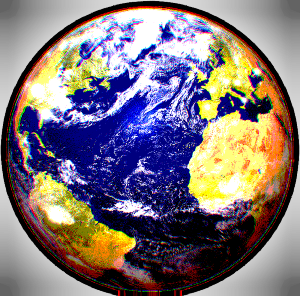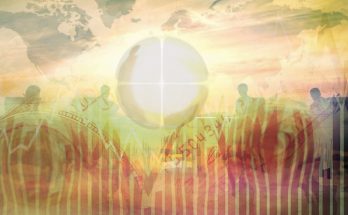Why do greenhouse gases let radiations in and why do they block it out!!!? Are they really biased? According to science sources “in the solar system, most of the thermal energy received by a planet comes from solar radiation and, in the absence of atmosphere, a planet radiates ideally like a black body, the atmosphere of a planet absorbs and reflects part of these radiations thus modifying the thermal balance. Thus the atmosphere isolates the Earth from space vacuum like a greenhouse isolates plants from the outside air.”
In 1886, Svante Arrhenius was the first to take an interest in the greenhouse effect that CO2 could cause, rejoicing in its impact on rising temperatures. In the 1920s, this hypothesis seems to be confirmed by the American Meteorological Bureau, which reports the total melting of known glaciers.
In the 1970s, it was the fear of “global cooling ” that gained ground. Since 1940, temperatures have dropped making Arrhenius’ theory dubious for some. In 1988, the magazine Ciel et Espace still titled, ” The return of the great colds “. The year 88 remains that in which the heat prevails definitively and sees the creation of the IPCC whose main function is to forge the opinion of decision-makers on climate issues, its theses being as follows:
1CO2 emissions of human origin have increased sharply, accentuating the greenhouse effect and warm the planet.
Ideas, researchers and a certain complexity
Skeptical climatologists
Contrary to popular speech, many climatologists and atmospheric specialists fiercely fight the positions of the IPCC. Richard Linzen (Massachusetts Institute of Technology-MIT) the most eminent of them is the bête noire of the carbocentrists. Roger Pielke (University of Colorado), Roy Spencer (University of Alabama), Marcel Leroux (University Lyon-3)… etc are just a few names on a long list.
The “solarists”
They constitute a battalion provided and structured (Henrik Svensmark and Eigil Friis-Christensen, Nir Shaviv, Nicolas Scafetta…). According to them, most of the recent climatic variations are explained by solar phenomena. Obviously the IPCC replies that its calculations take this phenomenon into account. However, it is not on the variations in illumination that the ” solarists” draw attention, but on the cycles of solar eruption which vary the quantity of ionizing particles which reach us. The latter seem to play a fundamental role in the formation of clouds and therefore in the evolution of the Earth’s temperature. The CLOUD experiment at CERN confirms this idea.
The ” oceanists “
The thermal energy contained in the oceans is immensely greater than that contained in the atmosphere and constitutes a major element which must be taken into account. An article by Gilbert Combo and Prashant Saderhmukh (University of Colorado) published in 2008 in the journal Climate Dynamics , offers an explanation according to which the temperature variations of the continents are dictated by those of the oceans and not by the greenhouse effect.
Geologists
The questions asked by this specialty are as many thorns planted in the official thesis. How to reconcile the IPCC thesis with the proven reality of ice ages during which the atmospheric CO2 content was higher (5 times more in the Cretaceous-Jurassic, 15 times more in the Ordovician-Silurian)? The international congress of geology which was held in August 2008 showed that many specialists in the field are in frontal disagreement with the theses of the IPCC.
Physicists
They may well put an end to all controversy. The general idea simplified is that CO2 would play the role of glass which, in a greenhouse, traps heat. Its increase would therefore be at the origin of the greenhouse effect. Physicists have strongly criticized this approach. It is established that water vapor alone is responsible for at least 60% of the greenhouse effect, some authors go up to 95%. More serious, the warming mechanism proposed by official theory, violates the second principle of thermodynamics. In the eyes of physicists, this defect is the worst that can happen to a scientific theory.
In 2008, the American Physical Society (APS), supporting the theory of the greenhouse effect, published the climate-skeptical point of view of Christoper Monckton. Subsequently several ten members of the APS expressed a skeptical position. In October 2009, more than one hundred and sixty physicists, including Ivar Giaver, Nobel Prize winner in physics in 1973, sent a letter to the United States Senate to denounce the official position of the APS, affirm that the consensus displayed is an illusion, and insist on the fact that ” consensus is not an acceptable test of scientific validity “.
Some other ideas
Environmental sciences, Earth, meteorology … are also manifested. Syun Akasofu (University of Alaska Fairbanks) protests against the image conveyed by the IPCC and the media of the evolution of ice floes. Other assertions of the IPCC are challenged by Christopher Landsea, hurricane specialist (American Federal Agency for Oceans and Atmosphere) or by Paul Reiter (Institut Pasteur) on the spread of epidemics… etc.
Conclusion
The situation seems a little more complicated than the IPCC and the media are willing to tell us, making modeling complicated. Yet nothing seems to shake the certainties of the IPCC, which is reluctant to admit its mistakes. The “hockey stick” curve is the most famous example.



